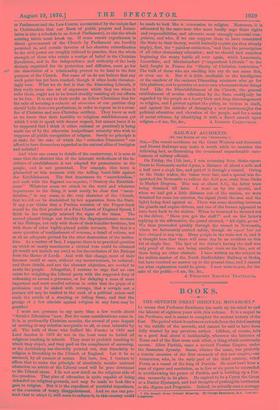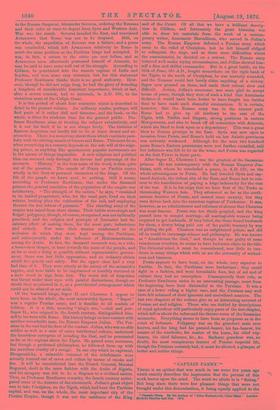BOOKS.
THE SEVENTH GREAT ORIENTAL MONARCHY.* IT seems that Professor Rawlinson lias made up his mind to end the labours of eighteen years with this volume. It is a sequel to his Parthians, and is meant to complete the ancient history of the East. The period which it embraces extends from the third century to the middle of the seventh, and cannot be said to have been fully treated by any previous author. Gibbon, of coarse, tells us a good deal about it incidentally, wherever the histories of Rome and of the East cross each other, a thing which continually occurs. After Parthia, came a revived Persian Empire, under the Sassanian dynasty. Sasan, whence the name, was probably a remote ancestor of the first monarch of this new empire,--an Artaxerxes, who, in the early part of the third century, ruled Persia as a vassal of the king of Parthia. He must have been a man of vigour and resolution, as in five or six years he succeeded in overthrowing the power of Parthia, and in building up a Per- sian monarchy in its place. He aspired to be a Cyrus the Great or a Darius Hystaspes, and had thoughts of pushing his territories to the /Egean and Propontis. Indeed, he actually sent a message
* 27as Seventh Great Oriental Mosarchr. By George Rawlineon, M.A. Lontoa to the Roman Emperor, Alexander Severna, ordering the Romans and their ruler at once to depart from Syria and Western Asia.
War was the result. Severna invaded the East, and convinced Artaxerxes that Rome was not to be despised. Still, on the whole, the expedition of Severna was a failure, and a peace
was concluded, which left Artaxerxes relatively to Rome in much the same position as the Parthian kings had occupied. It was, in fact, a return to the status quo ante helium, and as Artaxerxes soon afterwards possessed himself of Armenia, he
may be said to have come well out of the struggle. According to Gibbon, he penetrated into the remote regions of India and
Scythia, and won some easy victories, but for this statement Professor Rawlinson thinks there is no good authority. How- ever, though he did not reign long, he had the glory of founding a kingdom of considerable historical importance, which at last, after a severe contest, had to succumb, in A.D. 636, to the victorious arms of the Caliph Omar.
It is this period of about four centuries which is described in detail in the present volume. An ordinary reader, perhaps, will find parts of it rather dull and tiresome, and the book, on the whole, is fitter for students than for the general public. Pro- fessor Rawlinson aims at treating the subject exhaustively, and it is not his fault if he is not always lively. The histories of Eastern despotism can hardly fail to be at times dreary and un- attractive. There is a monotony about them which contrasts pain- fully with the stirring annals of Greece and Rome. This must be so, when everything in a country depends on the sole will of the reign- ing prince, as anything like spontaneous popular movements are in the nature of things impossible. A new religious and political idea can succeed only through the favour and patronage of the Monarch. "History," in the best sense of the word, is thus quite out of the question. The annals of Persia or Parthia centre wholly in the lives or personal characters of the kings. Of the
life of the people we know next to nothing. Still it seems, according to Professor Rawlinson, that under the Sassanid
princes the general condition of the population of the empire was
satisfactory. "The strength of the nation," he says, "consisted in its landed proprietors, who, for the most part, lived on their
estates, looking after the cultivation of the soil, and employing thereon the free labour of peasants." The standing army of the empire was raised from these classes. Their habits were simple and frugal ; polygamy, though, of course, recognised, was not habitually Factised, and the religion and precepts of Zoroaster had the salutary effect of making them, for the most part, industrious and orderly. Nor were their women condemned to the seclusion in which they were kept among the Parthians, and subsequently, under the influence of Mahommedanism, among the Arabs. In fact, the Sassanid monarch was, as a rule, a benevolent despot, at least towards the mass of the people, and as far as such a thing is possible without representative govern- ment, there was but little oppression, and an ordinary citizen could live quietly and safely. But the upper class had a very bad time of it. They were utterly at the mercy of the monarch's caprice, and were liable to be' imprisoned or horribly tortured at a mere word or sign from him. The worst side of despotism was thrust under their eyes with painful distinctness, though no doubt they acquiesced in it, as a providential arrangement which could not be altered or set aside.
Of the Sassanid kings, Sapor H. and Chosroes L appear to have been, on the whole, the most noteworthy figures. " Sapor " was a regular Persian name, and is familiar to all readers of Gibbon. It is a title, meaning "king's son,"—shah and puhr. Sapor H., who reigned in the fourth century, distinguished him- self in his wars with Rome. His history brings us into contact with another remarkable man, the Roman Emperor Julian. The Per- sians in the end had the best of the contest. Julian, who was an able soldier as well as a man of some intellectual culture, undertook the hazardous enterprise of invading the East, and he penetrated as far as the regions about the Tigris. He gained some successes, but though a professed philosopher, he followed them up with the merciless cruelty of a savage. In one city which he captured, Maogamalcha, a miserable remnant of the inhabitants were actually hunted out of caves and cellars by means of smoke and fire. It will be remembered that the French General, Marshal Bugeaud, dealt in the same fashion with the Arabs of Algeria, and his savagery was felt to be a disgrace to a civilised nation. Thus, as Professor Rawlinson remarks, the fourth century antici- pated some of the horrors of the nineteenth. Julian's great object was to take Ctesiphon, on the Tigris, which had been the Parthian capital, and was, on the whole, the most important city of the Persian Empire, though it was not the residence of the King
and of the Court. Of all this we have a brilliant descrip- tion in Gibbon, and fortunately the great historian was able to draw his materials from the work of a contem- porary writer, .Ammianus Marcellinus, who served in Julian's army. The Roman Emperor defeated a Persian army which came to the relief of Ctesiphon, but he felt himself obliged to relinquish the siege, and as there were difficulties about the commissariat, he decided on a retreat. The Roman army behaved well under trying circumstances, and Julian showed him- self a firm and skilful commander. But in a great battle, on the 26th of June, 363 A.D., fought somewhere on the right bank of the Tigris, to the north of Ctesiphon, he was mortally wounded, and the Romans could but barely claim anything of a victory. Sapor now pressed on them, and made their retreat slow and difficult. Jovian, Julian's successor, was soon glad to accept terms of peace, though they were of such a kind that Ammianus declares it would have been better to have fought ten battles than to have made such shameful concessions. It is certain, however, that the Roman army was in the utmost peril. Rome had to give up all territory to the east of the Tigris, with Nisibis and Singara, strong positions in eastern Mesopotamia, and also to break off all connection with Armenia, which she liked to look upon as a dependency. This was a great blow to Roman prestige in the East. Syria was now open to invasion from Persia, and Rome's hold on her Asiatic provinces was seriously weakened. Although for the next two hundred years Rome's Eastern possessions were not further curtailed, still her influence was felt to be on the wane, and Persia was regarded as the first Power in those parts.
After Sapor II., Chosroes I. was the greatest of the Sassanian princes. He was contemporary with the Roman Emperor Jus- tinian, with whom he concluded a peace, in A.D. 533, on the whole advantageous to Persia. He had invaded Syria and cap- tured Antioch, the richest city of the East, and Rome had to con- sent to the humiliation of .paying a huge indemnity for the cost of the war. It is in his reign that we hear first of the Turks as threatening Western Asia. They advanced as .far as the north- eastern frontier of Persia, and caused some anxiety, but they were driven back into the remotest regions of Turkestan. It was, however, as an administrator and reformer of abuses that Chosroes was most famous. Persia was too thinly peopled, and the king passed laws to compel marriage, all marriageable women being required to get husbands. If they failed, the State found husbands for them, a dowry being paid out of the public treasury by way of gilding the pill. Chosroes was an enlightened prince, and did all he could to encourage science and philosophy. He was known as " Anushirwan the Just," and though he was guilty of some treacherous cruelties, he seems to have had some claim to the title. The Oriental mind, it must be remembered, sees little to con- demn in many things which with us are the. extremity of wicked- ness and baseness.
Persia appears to have been, on the whole, very superior to Parthia. In fact, the Parthians were barbarians ; they could fight in a fashion, and were formidable foes, but of art and of culture they had no conception. Consequently their rule, as Professor Rawlinson notes in an interesting passage, must from the beginning have been distasteful to the Persians. It was a
came of a lower ruling a higher race, and the Persians may well have felt ashamed of their ignorant and uncivilised masters. The
last two chapters of the volume give us an interesting account of Persian art and religion. Those who are tickled by descriptions of royal splendour will particularly enjoy parts of the last chapter, which tell us about the robes and the throne-room of the Sassanian monarchs. Everything seems to have been as gorgeous as in the court of Solomon. Polygamy was on the grandest scale ever known, and the king had his parasol-bearer, his fan-bearer, his master of the wardrobe, his master of the horse, his chief cup- bearer, his chief falconer, &c., &c. Barbaric grandeur was, no doubt, the most conspicuous feature of Persian imperial life, though the Persians certainly had, it must be allowed, a glimpse of better and nobler things.































 Previous page
Previous page